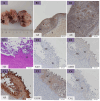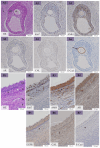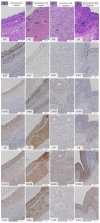Pathohistological Findings after Bilateral Ovariectomy in Mares with Behavioral Problems
- PMID: 39409848
- PMCID: PMC11475726
- DOI: 10.3390/ani14192899
Pathohistological Findings after Bilateral Ovariectomy in Mares with Behavioral Problems
Abstract
Behavioral problems in reproductively healthy mares are a challenging issue that is successfully treated with bilateral ovariectomy (BO). This laparoscopic procedure represents an alternative to conservative treatment for mares not intended for breeding and results in high owner satisfaction regarding behavioral improvement. However, a pathohistological explanation to justify surgical ovarian removal regarding animal welfare is lacking. Therefore, the objective of this study was to pathohistologically evaluate bilaterally removed, clinically unremarkable ovaries of mares with behavioral problems (bOE, n = 20) and to compare them with pathohistologically confirmed granulosa cell tumors of mares with neoplastic ovaries (GCT-uOE, n = 10). A complete data set including preliminary presentation, clinical examination, and serum anti-Müllerian hormone (AMH) and testosterone was further analyzed in both groups. Both hormones were significantly higher in GCT-uOE compared with bOE. Immunohistochemical expression of Ki-67, AMH, aromatase, epidermal growth factor receptor, calretinin, and epithelial cadherin in granulosa cells of large follicular structures in bOE did not differ from neoplastic granulosa cells in GCT-uOE. Ultrasonographically nondetectable early neoplastic changes were pathohistologically evaluated in 15% of mares and anovulatory-like follicles in 30% of mares in bOE and might be one explanation for the high success rate of BO in 85% of bOE in this study.
Keywords: anti-Müllerian hormone; behavior; equine ovary; granulosa cell tumor; immunohistochemical marker.
Conflict of interest statement
The authors declare no conflicts of interest.
Figures





References
-
- Jorgensen J.S., Vivrette S., Correa M., Mansmann R.A. Significance of the Estrous Cycle on Athletic Performance in Mares; Proceedings of the 42nd Annual Convention Am. Equine Pract; Denver, CO, USA. 8–9 December 1996; pp. 98–100.
-
- Pryor P., Tibary A. Management of estrus in the performance mare. Clin. Tech. Equine Pract. 2005;4:197–209. doi: 10.1053/j.ctep.2005.07.001. - DOI
-
- McDonnell S.M. Behavior problem: Ovaries or not?; Proceedings of the 63rd Annual Convention of the American Association of Equine Practitioners; San Antonio, TX, USA. 17–21 November 2017.
LinkOut - more resources
Full Text Sources
Research Materials

